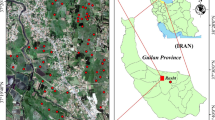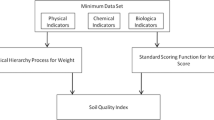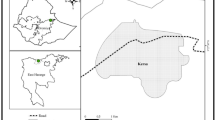Abstract
Purpose
Sustainable land management is considered an effective measure to ensure national food security by matching improved soil quality with enhanced crop productivity. The objectives of the present study were to evaluate soil quality status among paddy fields, vegetable fields, and pomelo orchards managed by continuous cropping systems, to establish a minimum data set (MDS) and recommend fertilization strategies to enhance productivity in acidic red soil hilly regions.
Materials and methods
The soil quality index (SQI) was calculated using the total data set (TDS) and MDS as indicator selection methods. A total of 51, 32, 44 soil samples (0–20 cm) were collected from different cropping systems in paddy fields, vegetable fields, and pomelo orchards, respectively. Eleven soil properties (geographical indicator (altitude) and 10 chemical parameters) were measured to evaluate soil quality of acidic red soil hilly regions in Pinghe County, Fujian province, southern China.
Results and discussion
The results showed significant differences in soil quality indicators between paddy fields, vegetable fields, and pomelo orchards, and altitude, total N, hydrolysable nitrogen (Avail-N), exchangeable calcium (Avail-Ca), and available zinc (Avail-Zn) were adopted as indicators in the MDS using principal component analysis (PCA). After scoring and weighting the selected indicators, the mean SQI scores of paddy field, vegetable field, and pomelo orchard soils were 0.267, 0.282, and 0.236 for TDS, respectively, and the SQI scores were 0.233, 0.256, and 0.166 for MDS. A significant positive correlation was observed between SQI and crop yield using both the TDS and MDS methods, indicating that the MDS method adequately represents the TDS method (R2 = 0.6839) for evaluation of the effects of farming production practices on soil quality. Overall, the unbalanced soil quality indicators, including rich in total N, organic matter and Avail-P, and deficient in Avail-N, Avail-K, Avail-Ca, Avail-Mg, Avail-Zn, and Avail-B, were implicated as the main limiting factors for crop production in the studied regions.
Conclusions
Compared with paddy and vegetable fields, the lower total N and Avail-N status at higher altitudes were considered as the major factors limiting pomelo productivity. Therefore, there is a great potential for increasing pomelo productivity by improving soil quality with integrated nutrient management in acidic red soil hilly regions.







Similar content being viewed by others
References
Andrews SS, Carroll CR (2001) Designing a soil quality assessment tool for sustainable agroecosystem management. Ecol Appl 11:573–585
Andrews SA, Mitchell JP, Mancinelli R, Karlen DL, Hartz TK, Horwath WR, Pettygrove GS, Scow KM, Munk DS (2002) On-farm assessment of soil quality in California’s central valley. Agron J 94:12–23
Bandick AK, Dick RP (1999) Field management effects on soil enzyme activities. Soil Biol Biochem 31:1471–1479
Bastida F, Zsolnay A, Hernández T, García C (2008) Past, present and future of soil quality indices: a biological perspective. Geoderma 147:159–171
Bhardwaj AK, Jasrotiaa P, Hamiltona SK, Robertson GP (2011) Ecological management of intensively cropped agro-ecosystems improves soil quality with sustained productivity. Agric Ecosyst Environ 140:419–429
Bouwman AF (1990) Global distribution of the major soils and land cover types. In: Bouwman AF (ed) Soils and the greenhouse effect. John Wiley & Sons, Chichester, pp 33–57
Brejda JJ, Moorman TB, Karlen DL, Dao H (2000) Identification of regional soil quality factors and indicators. Central and Southern High Plains. Soil Sci Soc Am J 64:2115–2124
Bu X, Ruan H, Wang L, Ma W, Ding J, Yu X (2012) Soil organic matter in density fractions as related to vegetation changes along an altitude gradient in the Wuyi Mountains, southeastern China. Appl Soil Ecol 52:42–47
Cakmak I (2008) Enrichment of cereal grains with zinc: agronomic or genetic biofortification? Plant Soil 302:1–17
Chen X, Cui Z, Fan M, Vitousek P, Zhao M, Ma W, Wang Z, Zhang W, Yan X, Yang J, Deng X, Gao Q, Zhang Q, Guo S, Ren J, Li S, Ye Y, Wang Z, Huang J, Tang Q, Sun Y, Peng X, Zhang J, He M, Zhu Y, Xue J, Wang G, Wu L, An N, Wu L, Ma L, Zhang W, Zhang F (2014) Producing more grain with lower environmental costs. Nature 514:486–489
Dieleman WIJ, Venter M, Ramachandra A, Krockenberger AK, Bird MI (2013) Soil carbon stocks vary predictably with altitude in tropical forests: implications for soil carbon storage. Geoderma 204-205:59–67
Doran JW, Parkin TB (1994) Defining and assessing soil quality. In: Doran JW (ed) Defining soil quality for a sustainable environment. Soil Science Society of America Special Publication, Madison, pp 3–21
Fageria NK, Baligar VC (1999) Growth and nutrient concentrations of common bean, lowland rice, corn, soybean, and wheat at different soil pH on an inceptisol. J Plant Nutr 22:1495–1507
Fernández-Ugalde O, Virto T, Bescausa P, Imaz MJ, Enrique A, Karlen DL (2009) No-tillage improvement of soil physical quality in calcareous, degradation-prone, semiarid soils. Soil Tillage Res 106:29–35
Gong P (2011) China needs no foreign help to feed itself. Nature 474:7
Guo H, Mazer SJ, Du G (2010a) Geographic variation in seed mass within and among nine species of Pedicularis (Orobanchaceae): effects of elevation, plant size and seed number per fruit. J Ecol 98:1232–1242
Guo JH, Liu XJ, Zhang Y, Shen JL, Han WX, Zhang WF, Christie P, Goulding KWT, Vitousek PM, Zhang FS (2010b) Significant acidification in major Chinese cropland. Science 327:1008–1010
Guo H, Weiner J, Mazer SJ, Zhao Z, Du G, Li B (2012) Reproductive allometry in Pedicularis species changes with elevation. J Ecol 100:452–458
Guo JX, Feng XM, Hu XY, Tian GL, Ling N, Wang JH, Shen QR, Guo SW (2016) Effects of soil zinc availability, nitrogen fertilizer rate and zinc fertilizer application method on zinc biofortification of rice. J Agric Sci 154:584–597
Huang B, Sun WX, Zhao YC, Zhu J, Yang RQ, Zou Z, Ding F, Su JP (2007) Temporal and spatial of soil organic matter and total nitrogen in an agricultural ecosystem as affected by farming practices. Geoderma 139:336–345
Industry standard of ministry of agriculture of the people’s republic of China (ISMAPRC) (1996) Classification of type regions and fertility of cultivated land in China (NY/T 309–1993)
IUSS Working Group WRB (2014) World reference base for soil resources 2014. International soil classification system for naming soils and creating legends for soil maps. World Soil Resources Reports No. 106. FAO, Rome
Karlen DL, Wollenhaupt NC, Erbach DC, Berry EC, Swan JB, Eash NS, Jordahl JL (1994) Crop residue effects on soil quality following 10-years of no-till corn. Soil Tillage Res 31:149–167
Karlen DL, Andrews SS, Doran JW (2001) Soil quality: current concepts and applications. Adv Agron 74:145–156
Karlen DL, Ditzler CA, Andrews SS (2003) Soil quality: why and how? Geoderma 113:145–156
Kemmitt SJ, Wright D, Jones DJ (2005) Soil acidification used as a management strategy to reduce nitrate losses from agricultural land. Soil Biol Biochem 37:867–875
Li P, Zhang TL, Wang XX, Yu DS (2013) Development of biological soil quality indicator system for subtropical China. Soil Tillage Res 126:112–118
Li Y, Han MQ, Lin F, Ten Y, Lin J, Zhu DH, Guo P, Weng YB, Chen LS (2015) Soil chemical properties, ‘Guanximiyou’ pummelo leaf mineral nutrient status and fruit quality in the southern region of Fujian province, China. J Soil Sci Plant Nut 15:615–628
Liebig MA, Varvel G, Doran JW (2001) A simple performance-based index for assessing multiple agroecosystem functions. Agron J 93:313–318
Lin S, Iqbal J, Hu R, Ruan L, Wu J, Zhao J, Wang P (2012) Differences in nitrous oxide fluxes from red soil under different land uses in mid-subtropical China. Agr Ecosys Environ 146:168–178
Liu ZJ, Zhou W, Shen JB, Li ST, Liang GQ, Wang XB, Sun JW, Ai C (2014a) Soil quality assessment of acid sulfate paddy soils with different productivity in Guangdong province, China. J Integr Agric 13:177–186
Liu Z, Zhou W, Shen J, Li S, Ai C (2014b) Soil quality assessment of yellow clayey paddy soils with different productivity. Biol Fertil Soils 50:537–548
Liu Z, Zhou W, Shen J, Li S, He P, Liang G (2014c) Soil quality assessment of Albic soils with different productivities for eastern China. Soil Tillage Res 140:74–81
Liu H, Liu G, Li Y, Wu X, Liu D, Dai X, Xu M, Yang F (2016) Effects of land use conversion and fertilization on CH4 and N2O fluxes from typical hilly red soil. Environ Sci Pollut Res 23:20269–20280
Long A, Zhang J, Yang LT, Ye X, Lai NW, Tan LL, Lin D, Chen LS (2017) Effects of low pH on photosynthesis, related physiological parameters, and nutrient profiles of Citrus. Front Plant Sci 8:185
Manlay RJ, Feller C, Swift MJ (2007) Historical evolution of soil organic matter concepts and their relationships with the fertility and sustainability of cropping systems. Agric Ecosyst Environ 119:217–233
Marzaioli R, D'Ascoli R, de Pascale RA, Rutigliano FA (2010) Soil quality in a Mediterranean area of southern Italy as related to different land use types. Appl Soil Ecol 44:205–212
Mowo JG, Janssen BH, Oenema O, German LA, Mrema JP, Shemdoe RS (2006) Soil fertility evaluation and management by smallholder farmer communities in northern Tanzania. Agric Ecosyst Environ 116:47–59
Myaer R (1998) Soil acidification and cycling of metal elements: cause-effect relationships with regard to forestry practices and climatic changes. Agric Ecosyst Environ 67:145–152
Pan GX, Smith P, Pan WN (2009) The role of soil organic matter in maintaining the productively and yield stability of cereals in China. Agric Ecosyst Environ 129:344–348
Qi Y, Darilek JL, Huang B, Zhao Y, Sun W, Gu Z (2009) Evaluating soil quality indices in an agricultural region of Jiangsu Province, China. Geoderma 149:325–334
Rehman H, Aziz T, Faroop M, Wakeel A, Rengel Z (2012) Zinc nutrition in rice production systems: a review. Plant Soil 361:203–226
Rezaei SA, Gilkes RJ, Andrews SS (2006) A minimum data set for assessing soil quality in rangelands. Geoderma 136:229–234
Romaniuk R, Giuffré L, Costantini A, Bartoloni N, Nannipieri P (2012) A comparison of indexing methods to evaluate quality of soils: the role of soil microbiological properties. Soil Res 49:733–741
Shukla MK, Lal R, Ebinger M (2006) Determining soil quality indicators by factor analysis. Soil Tillage Res 87:194–204
Soil Survey Staff (2014) Keys to soil taxonomy, 12th edn. USDA, Washington
Tan Q, Wang G (2016) Decoupling of nutrient element cycles in soil and plants across an altitude gradient. Sci Rep 6:34875
Wan SZ, Gu HJ, Yang QP, Hu XF, Fang XM, Singh AN, Chen FS (2017) Long-term fertilization increases soil nutrient accumulations but decreases biological activity in navel orange orchards of subtropical China. J Soils Sediments 17:2346–2356
Wang X, Zou C, Zhang Y, Shi X, Liu J, Fan S, Liu Y, Du Y, Zhao Q, Tan Y, Wu C, Chen X (2018) Environmental impacts of pepper (Capsicum annuum L) production affected by nutrient management: a case study in southwest China. J Clean Prod 171:934–943
Xu M, Li X, Cai J, Li X, Christie P, Zhang J (2014) Soil microbial community structure and activity along a montane elevational gradient on the Tibetan Plateau. Eur J Soil Biol 64:6–14
Xu X, Liu H, Fu B, Wang Q, Xu M, Wang H, Yang F, Liu G (2017) Effects of land-use change and fertilization on N2O and NO fluxes, the abundance of nitrifying and denitrifying microbial communities in a hilly red soil region of southern China. Appl Soil Ecol 120:111–120
Yao RJ, Yang JG, Gao P, Zhang JB, Jin WH (2013) Determining minimum data set for soil quality assessment of typical salt-affected farmland in the coastal reclamation area. Soil Tillage Res 128:137–148
Zhang W, Cao G, Li X, Zhang H, Wang C, Liu Q, Chen X, Cui Z, Shen J, Jiang R, Mi G, Miao Y, Zhang F, Dou Z (2016) Closing yield gaps in China by empowering smallholder farmers. Nature 537:671–674
Acknowledgements
The authors are grateful to Lvlin Huang and Mulai Zhuang of the Pinghe Agriculture Bureau for providing the meteorological data and for their help with the sample collection, and to Yisong Wei, Ningtai Hong, Huicheng Wang, and Hai Tao of the FAFU for their assistance both in the field and the laboratory.
Funding
This study was financially supported by the Natural Science Foundation of China (31801947), the Natural Science Foundation of Fujian Province of China (2018J01708), the Special Fund for Scientific and Technological Innovation of the FAFU (CXZX2017229), the International Magnesium Institute Program (2018-MR0201), the MATS program of the Ministry of Agriculture of China (CARS-26-01A), and the Undergraduate Training Program for Innovation and Entrepreneurship of Fujian Province of China (201810389099).
Author information
Authors and Affiliations
Corresponding authors
Additional information
Responsible editor: Weixin Ding
Publisher’s note
Springer Nature remains neutral with regard to jurisdictional claims in published maps and institutional affiliations.
Rights and permissions
About this article
Cite this article
Guo, J., Yang, J., Zhang, L. et al. Lower soil chemical quality of pomelo orchards compared with that of paddy and vegetable fields in acidic red soil hilly regions of southern China. J Soils Sediments 19, 2752–2763 (2019). https://doi.org/10.1007/s11368-019-02273-y
Received:
Accepted:
Published:
Issue Date:
DOI: https://doi.org/10.1007/s11368-019-02273-y




